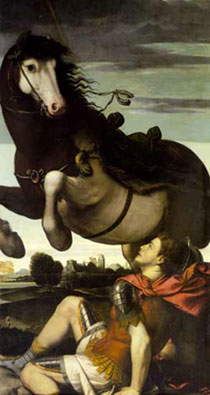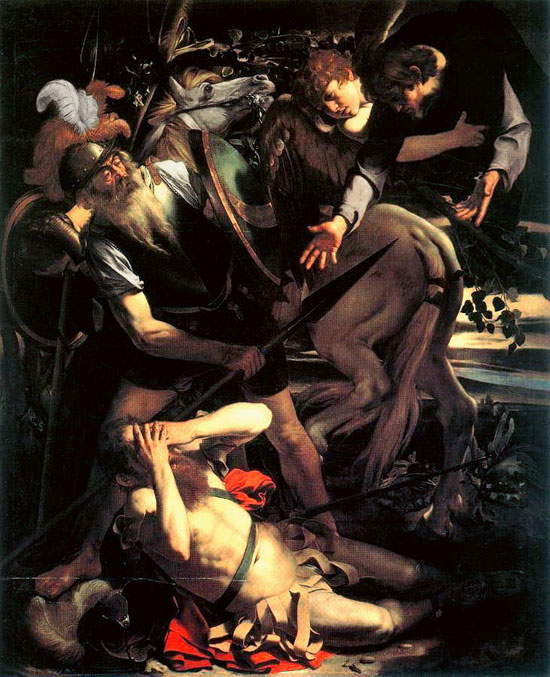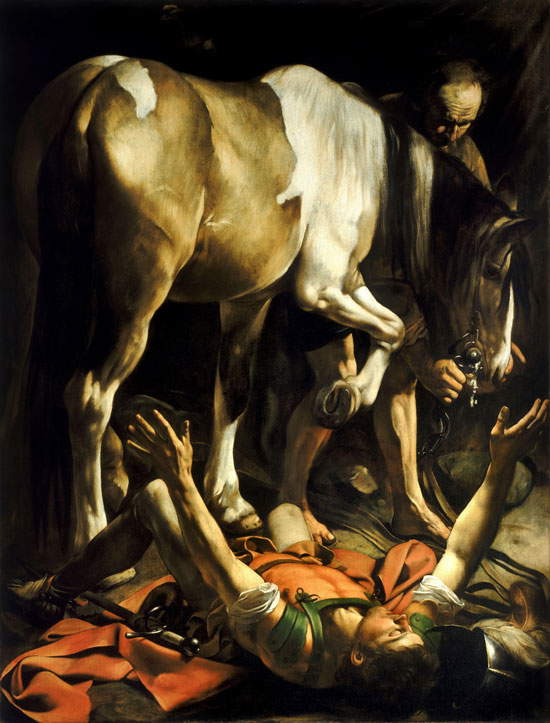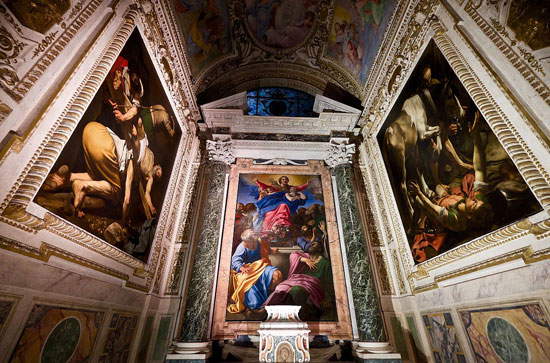Concerning Caravaggio ’s (Milan, 1571 - Porto Ercole, 1610) celebrated Conversion of St. Paul in the Cerasi Chapel, a painting that represents one of the Lombard artist’s best-known and most discussed masterpieces, there is a widespread interpretation that is too often taken for granted: that the painter created the work after being refused a first version, the one currently owned by the Odescalchi family, because it was not considered decorous by the heirs of the commissioner, Monsignor Tiberio Cerasi. Caravaggio is therefore said to have painted a second version, the one we can still admire today inside the chapel, considered even more irreverent, as it had the horse (or rather: his derriere) as the main protagonist instead of the saint.
 |
| Rome, the basilica of Santa Maria del Popolo inside which the Cerasi Chapel is located. |
 |
| Moretto, Conversion of St. Paul (1540-1541; oil on canvas, 306 x 136 cm; Milan, Santa Maria presso San Celso) |
To understand, therefore, how things really went, it is perhaps necessary to make a comparison between the two paintings. The Odescalchi Conversion, chronologically earlier, presents us with a swirling movement, still of Mannerist matrix: in this convulsive scene we see Saul (the future St. Paul) thrown to the ground and literally blinded by the light emanating from the apparition of Jesus Christ, who appears in the upper right corner. A light that invests Saul (who, as is well known, was a Jew who persecuted Christians) with such force that he is forced to make himself a screen with his hands as Jesus utters toward him the famous words, “Saul, Saul, why do you persecute me?” The episode is recounted in the Acts of the Apostles: soon after, Jesus would command Saul to enter the city of Damascus, where he would then complete his conversion to Christianity, moreover becoming one of the first evangelizers. In the painting, the horse, frightened by the divine apparition, is held in check by a groom who harnesses a spear and shield to shield himself in turn from the light, and to complete the list of protagonists we have an additional soldier, and an angel who assists Jesus by holding him with one arm.
 |
| Caravaggio, Conversion of St. Paul (c. 1600-1601; oil on panel, 237 x 189 cm; Rome, Odescalchi Collection) |
An entirely different (and in some ways opposite) atmosphere reigns in the Conversion in the Cerasi Chapel. The figures have been reduced in number, since Jesus, the angel and the second soldier have disappeared. Saul is still on the ground, overcome by the light, but he no longer tries to resist, rather: he opens his arms wide as if to welcome the divine light. Finally, the charge of violent pathos that permeated the Odescalchi Conversion has been drastically reduced: the horse now seems calm, and even the groom, who assumes a composed and calm attitude, has a much easier time leading it away from Saul in order to prevent the man from being trampled by the animal. The fact is that Michelangelo Merisi chooses to depict, in this painting, the moment immediately following the moment of the apparition: Jesus has already spoken his words, has withdrawn, leaving behind the last bright flashes of light, and has left Saul on the ground, left as if thunderstruck. This istruly Caravaggio’smost original invention: having avoided depicting the climax of the episode and instead focused on the following one.
 |
| Caravaggio, Conversion of St. Paul (ca. 1601-1605; oil on canvas, 230 x 175 cm; Rome, Santa Maria del Popolo, Cerasi Chapel) |
We can, therefore, take a step back, and question why Caravaggio changed his work so drastically: from a highly dramatic and more crowded painting to one that is more serene and, above all, characterized by the novelty mentioned just above. Scholars such as Luigi Spezzaferro and Rossella Vodret have advanced the hypothesis that it was Caravaggio himself who decided to change the painting during the course of the work. Tiberio Cerasi, in fact, had commissioned not only the paintings, but also the architectural rearrangement of the chapel, which was entrusted to Carlo Maderno. As anyone who sets foot in the chapel can see, Maderno devised a narrow and reduced space, perhaps with the aim of making the viewer emotionally highly involved: probably Caravaggio, seeing how the work of rearranging the space was progressing, felt that his paintings (remember that, in addition to the Conversion, he had also been commissioned to paint a Crucifixion of St. Peter, the first version of which has been lost), intended for the side walls of the chapel, were ill-suited to the spaces envisaged by Maderno, and were also incapable of dialoguing effectively with the splendid Assumption by Annibale Carracci (Bologna, 1560 - Rome, 1609), a great masterpiece of the Bolognese painter that had perhaps already been installed on the back wall. The artist would therefore have thought of two new paintings that, together with the Annibale painting, would concur to offer the viewer the illusion of being in front of a real space. Indeed, it is clear that Caravaggio made his painting with an observer forced to look at it from the side, in a confined space in mind: for this reason, an oblique point of view was adopted, also suggested by the diagonals of the horse’s body and head on one side, and of the saint’s right arm on the other, which converge toward the center on the right side of the work (and, vice versa, on the left side the diagonals diverge). The hypothesis of a Caravaggio choosing independently to execute new versions of his paintings to adapt them to the chapel would also allow us to move their execution forward: probably around 1605 (thus coinciding with the year of their placement on the walls, which we know from documents), a dating that would also explain the considerable stylistic gap between the Odescalchi Conversion and that of the chapel.
 |
| The Cerasi Chapel with the painting by Annibale Carracci on the back wall and those by Caravaggio on the side walls. Credit |
Add to this an interpretation offered by Maurizio Calvesi, which would also explain, in an allegorical key, why the importance given to the horse. The Cerasi Chapel is located inside the basilica of Santa Maria del Popolo, the seat of the Augustinian order: we know that St. Augustine was one of the main theorists of divine Grace, which represents the main concept of his philosophical system, as the means that allows humanity to save itself and, of course, to rise above sin, which man necessarily experiences in the course of his existence. Light, in the painting, symbolizes divine Grace, while the horse is given a central role since, according to this interpretation, it would become a symbol of sin and its irrationality (the horse, being an animal, is not endowed with reason).
Seen in this way, the work would thus no longer appear to be the product of a painter who only intended to make fun of the dominant thought of his time: instead, it would be a deeply meditated work, created with the approval of the patrons. Does this view help to dilute the myth, so much in vogue in recent years, of the cursed painter who is constantly nonconformist and reluctant to abide by the rules? The answer can only be negative, because we are well aware of the excesses to which the Lombard artist was accustomed: but certainly, the hypotheses about the Conversion of St. Paul help to provide a more realistic and complete reconstruction of the complex events that the painting experienced. Without in the least affecting the aura that surrounds the figure of Caravaggio.
Reference bibliography
Warning: the translation into English of the original Italian article was created using automatic tools. We undertake to review all articles, but we do not guarantee the total absence of inaccuracies in the translation due to the program. You can find the original by clicking on the ITA button. If you find any mistake,please contact us.